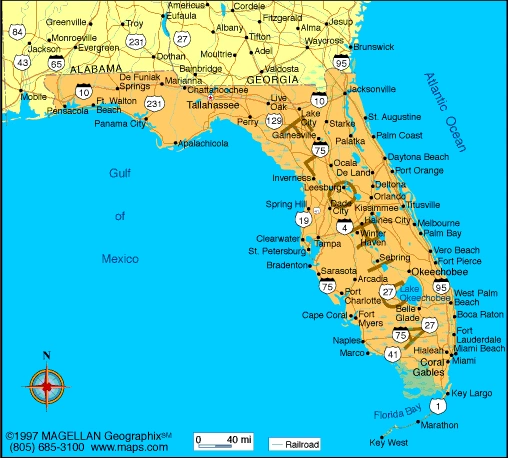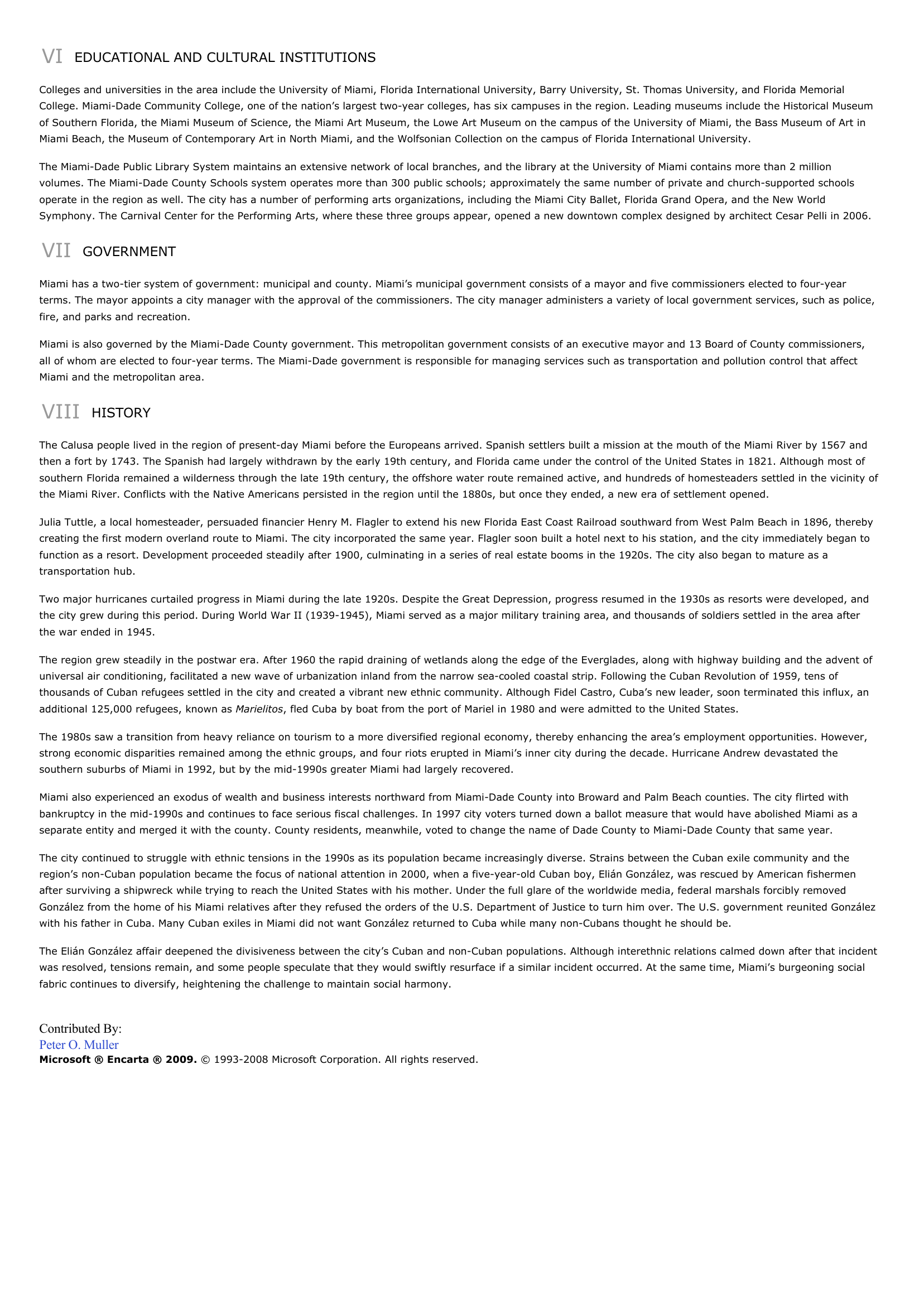Miami (Florida) - geography.
Publié le 04/05/2013
Extrait du document


«
VI EDUCATIONAL AND CULTURAL INSTITUTIONS
Colleges and universities in the area include the University of Miami, Florida International University, Barry University, St.
Thomas University, and Florida MemorialCollege.
Miami-Dade Community College, one of the nation’s largest two-year colleges, has six campuses in the region.
Leading museums include the Historical Museumof Southern Florida, the Miami Museum of Science, the Miami Art Museum, the Lowe Art Museum on the campus of the University of Miami, the Bass Museum of Art inMiami Beach, the Museum of Contemporary Art in North Miami, and the Wolfsonian Collection on the campus of Florida International University.
The Miami-Dade Public Library System maintains an extensive network of local branches, and the library at the University of Miami contains more than 2 millionvolumes.
The Miami-Dade County Schools system operates more than 300 public schools; approximately the same number of private and church-supported schoolsoperate in the region as well.
The city has a number of performing arts organizations, including the Miami City Ballet, Florida Grand Opera, and the New WorldSymphony.
The Carnival Center for the Performing Arts, where these three groups appear, opened a new downtown complex designed by architect Cesar Pelli in 2006.
VII GOVERNMENT
Miami has a two-tier system of government: municipal and county.
Miami’s municipal government consists of a mayor and five commissioners elected to four-yearterms.
The mayor appoints a city manager with the approval of the commissioners.
The city manager administers a variety of local government services, such as police,fire, and parks and recreation.
Miami is also governed by the Miami-Dade County government.
This metropolitan government consists of an executive mayor and 13 Board of County commissioners,all of whom are elected to four-year terms.
The Miami-Dade government is responsible for managing services such as transportation and pollution control that affectMiami and the metropolitan area.
VIII HISTORY
The Calusa people lived in the region of present-day Miami before the Europeans arrived.
Spanish settlers built a mission at the mouth of the Miami River by 1567 andthen a fort by 1743.
The Spanish had largely withdrawn by the early 19th century, and Florida came under the control of the United States in 1821.
Although most ofsouthern Florida remained a wilderness through the late 19th century, the offshore water route remained active, and hundreds of homesteaders settled in the vicinity ofthe Miami River.
Conflicts with the Native Americans persisted in the region until the 1880s, but once they ended, a new era of settlement opened.
Julia Tuttle, a local homesteader, persuaded financier Henry M.
Flagler to extend his new Florida East Coast Railroad southward from West Palm Beach in 1896, therebycreating the first modern overland route to Miami.
The city incorporated the same year.
Flagler soon built a hotel next to his station, and the city immediately began tofunction as a resort.
Development proceeded steadily after 1900, culminating in a series of real estate booms in the 1920s.
The city also began to mature as atransportation hub.
Two major hurricanes curtailed progress in Miami during the late 1920s.
Despite the Great Depression, progress resumed in the 1930s as resorts were developed, andthe city grew during this period.
During World War II (1939-1945), Miami served as a major military training area, and thousands of soldiers settled in the area afterthe war ended in 1945.
The region grew steadily in the postwar era.
After 1960 the rapid draining of wetlands along the edge of the Everglades, along with highway building and the advent ofuniversal air conditioning, facilitated a new wave of urbanization inland from the narrow sea-cooled coastal strip.
Following the Cuban Revolution of 1959, tens ofthousands of Cuban refugees settled in the city and created a vibrant new ethnic community.
Although Fidel Castro, Cuba’s new leader, soon terminated this influx, anadditional 125,000 refugees, known as Marielitos , fled Cuba by boat from the port of Mariel in 1980 and were admitted to the United States.
The 1980s saw a transition from heavy reliance on tourism to a more diversified regional economy, thereby enhancing the area’s employment opportunities.
However,strong economic disparities remained among the ethnic groups, and four riots erupted in Miami’s inner city during the decade.
Hurricane Andrew devastated thesouthern suburbs of Miami in 1992, but by the mid-1990s greater Miami had largely recovered.
Miami also experienced an exodus of wealth and business interests northward from Miami-Dade County into Broward and Palm Beach counties.
The city flirted withbankruptcy in the mid-1990s and continues to face serious fiscal challenges.
In 1997 city voters turned down a ballot measure that would have abolished Miami as aseparate entity and merged it with the county.
County residents, meanwhile, voted to change the name of Dade County to Miami-Dade County that same year.
The city continued to struggle with ethnic tensions in the 1990s as its population became increasingly diverse.
Strains between the Cuban exile community and theregion’s non-Cuban population became the focus of national attention in 2000, when a five-year-old Cuban boy, Elián González, was rescued by American fishermenafter surviving a shipwreck while trying to reach the United States with his mother.
Under the full glare of the worldwide media, federal marshals forcibly removedGonzález from the home of his Miami relatives after they refused the orders of the U.S.
Department of Justice to turn him over.
The U.S.
government reunited Gonzálezwith his father in Cuba.
Many Cuban exiles in Miami did not want González returned to Cuba while many non-Cubans thought he should be.
The Elián González affair deepened the divisiveness between the city’s Cuban and non-Cuban populations.
Although interethnic relations calmed down after that incidentwas resolved, tensions remain, and some people speculate that they would swiftly resurface if a similar incident occurred.
At the same time, Miami’s burgeoning socialfabric continues to diversify, heightening the challenge to maintain social harmony.
Contributed By:Peter O.
MullerMicrosoft ® Encarta ® 2009. © 1993-2008 Microsoft Corporation.
All rights reserved..
»
↓↓↓ APERÇU DU DOCUMENT ↓↓↓
Liens utiles
- Miami (Florida) - geography.
- Art Deco I INTRODUCTION Art Deco Historic District The Art Deco Historic District is located at the southern end of Miami Beach, Florida.
- Jacksonville (Florida) - geography.
- Jacksonville (Florida) - geography.
- le regime miami







